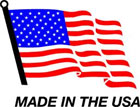| |
|
| |
|
 |
Supply
Chain by the Numbers |
| |
|
| |
- Dec. 7, 2017 -
|
| |
|
| |
|
| |
|
| |
Big Economic Prize from US Manufacturing Resurgence; ELD Mandate for US Truck Drivers Looms; Container Carriers Just Can't Stop Order Megaships; NAFTA Renewal Odds Not Good |
| |
|
| |
| |
| |
$530
Billion |
 |
| That's is how much could be added to the US economy by 2025 under the most optimistic of three scenarios for the direction of US manufacturing, according to a new analysis by the McKinsey Global Institute. What's more, that $530 billion of additional manufacturing "value-add" versus the current trajectory will create some 2.4 million direct manufacturing jobs and 3.3 million total new jobs, McKinsey estimates, even as manufacturing plants become more automated. "Given the importance of manufacturing to the broader economy, capturing these opportunities should be a national priority," McKinsey says. However, "No one should underestimate the effort it will take to turn things around." Recommended actions include business and government programs to boost the base of small and medium suppliers, helping smaller US firms with exporting expertise, embracing digitization and apprentice-like programs to expand the workforce. |
|
|
| |
| |
|
|
|
That's how many container ships over 18,000 TEU are currently on order, according to recent analysis from Drewry Shipping. Combined with 65 currently active ships of that size, that makes 210 of the so-called Ultra Large Container Vessels (ULCVs), or what we used to just call megaships, either on these seas or expected to come on-line soon. Both CMA CGM and MSC have recently placed major orders for ULCVs. Then Cosco Shipping Holdings announced plans to raise a huge $1.9 billion war chest through the issuance of new shares of stock, which will be used to part fund the purchase of 20 new ships, including 11 units over 20,000 TEU. There are reports that Hyundai Merchant Marine is planning to splurge on as many as 14 vessels of up to 22,000 TEU. After a year in which the demand-supply balanced moved a bit back in the carriers' favor, they just can't seem to stop themselves from buying more new ship orders, which likely will keep rates low, in good news for shippers. |
| |
| |
|
| |
| |
50% |
 |
That is the chance the North American Free Trade Agreement of NAFTA will be terminated, according to Mexico's ambassador to the US Gerónimo Gutiérrez, in an interview with CBS News this week. That follows a fifth round of renegotiations among the U.S., Mexico, and Canada that concluded last month in Mexico City on the nearly 24-year-old free trade agreement. A sixth round of talks begins January 23 in Montreal. Meanwhile, US Trade Representative Robert Lighthizer said in a statement Nov. 21: "I remain concerned about the lack of headway. Thus far, we have seen no evidence that Canada or Mexico are willing to seriously engage on provisions that will lead to a rebalanced agreement." What supply chain and economic turmoil would come from an end to NAFTA is hard to predict – but clearly the US automotive supply chain would be thrown for a loop. Mexico's production and exports of light vehicles this year through November have already surpassed the record levels set in 2016, with exports up 12% to 2.85 vehicles through November.
|
| |
| |
|
|
|
| |
 |
 |
| |
|
|
| |